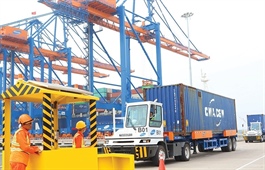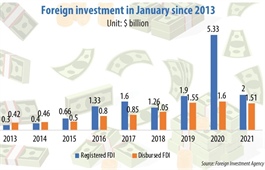A legal template to build on for development of SMEs
A legal template to build on for development of SMEs
With the new Law on Investment 2020 already in place, big opportunities are there for local firms to flourish. Tran Ngoc Han, senior associate from US-backed law firm Russin & Vecchi Vietnam, writes about positive signals for development of small- and medium-sized enterprises on the back of the law.

Tran Ngoc Han, senior associate from US-backed law firm Russin & Vecchi Vietnam
|
The new Law on Investment 2020 came into effect in January 1 and inherits the spirit of its predecessor by providing additional investment incentives. Article 15 describes new forms of incentives, new types of projects, and enterprises entitled to incentives.
Under the Law on Investment 2014, a project with investment capital of VND6 trillion ($260.87 million) or more, and which at least VND6 trillion is released within three years after the issuance of investment registration certificate, qualified for investment incentives.
The 2020 law narrows such projects by adding supplementary requirements. Now, together with releasing VND6 trillion within three years, in order to enjoy incentives, such projects must also generate minimum total annual revenue of VND10 trillion ($434.78 million) within three years from the year of generating revenue. Alternatively, it must have at least 3,000 permanent employees.
Also included are projects which employ the disabled or construct social-housing; investment and innovation projects which create research and development centres; and various projects which relate to tech transfer, tech enterprise incubators; or those in providing technology, equipment, products, and services to serve environmental protection requirements.
Finally, it also covers projects to encourage development of small- and medium-sized enterprises (SMEs), such as investment in their distribution chains; investment in technical establishments to support them; SME incubators; and investment in common working space to support startups.
Investment incentives can encourage development of SMEs, and specific conditions as well as specific tips to obtain incentives have been laid out.
Improved business environment
Based on statistics from the Vietnam Academic Social Sciences in 2020, there were 541,753 SMEs operating in various sectors with a total registered capital of VND130 billion ($5.65 million) and which make up 40 per cent of GDP. These SMEs contributed 30 per cent of the state budget and employed 60 per cent of the population nationwide.
Policies to support SMEs have been gradually developed by the government in various stages through the issuance of the law on support for SMEs in 2017, Decree No.39/2018/ND-CP from 2018, and other guidelines to create positive and strong assistance for SME development.
Currently, SMEs benefit from support on information, consultancy, and human resource development; support on use of technical equipment, technical application and transfer; and support on administrative procedures, technical application, or facilitation to approach financial supporting resources.
The government has consistently sought ways to improve investment and the business environment, to perfect regulations and to create motivations in order to enhance the SME system. Particularly, in addition to current incentives and facilitation for SMEs as summarised, the Law on Investment 2020 grants certain incentives to projects with investment targets to develop SMEs.
These include corporate income tax (CIT) incentives, such as application of a reduced rate or exemption; exemption of import duty on goods imported to form fixed asset, raw materials, supplies, and components; exemption or reduction of land rent, land use fees and land use taxes; and accelerated depreciation and more generous inclusion of deductible expenses to calculate taxable income.
Although the projects which focus on SME support have been added as being entitled to investment incentives, the Law on Investment 2020 does not provide specific conditions that an investor must meet to qualify for incentives. The government is in the process of providing guidelines to ensure clearer and simpler explanations.
Based on the proposed draft decree guiding certain articles of the Law on Investment 2020, to be entitled to investment incentives, investors and their projects which will invest in the SME system must meet specific requirements depending on each type of project.
(i) For projects to develop distribution chains of SMEs, an investor aims to enjoy these incentives should ensure:
+ The distribution chain is comprised of at least 80 per cent of SMEs to provide and sell their products. Rules to determine a qualified SME must be based on its main business operations, total registered capital, the number of employees covered by social insurance, and revenue in the preceding year;
+ The distribution chain must have at least 10 locations/outlets to distribute products to consumers; and
+ Revenue of SMEs in such a chain must reach at least 50 per cent of the total revenue of the distribution chain;
(ii) For investment projects that incubate SMEs and develop common working space to support them, investors must satisfy:
+ Requirements regarding location/premise; for example, the working space or conference room must accommodate 25 persons, and be fitted out with necessary office/technical equipment; and
+ A minimum number of management personnel or experts with suitable experience. These management personnel will provide training, consulting on investment plans as advisors of targeted SMEs.
As SMEs play an important role in the economy, and as the government seeks to balance innovation policies, business operations that support SMEs are encouraged. Specific conditions and steps to obtain incentives are in the final stages.

Decrees and guidelines in recent years have helped to gradually develop policies for supporting SMEs, photo Le Toan
|
Identify and prepare
There are practical tips for an investor to apply for incentives. They must ensure the business lines and/or investment project is compatible with requirements for receiving investment incentives. The scope of projects must be strictly consistent with requirements of qualifying projects as mentioned, to ensure that incentives will be duly granted.
Investors should identify appropriate incentives for a specific project. Normally, for projects that are required to obtain an investment registration certificate (IRC), investment incentives are indicated in the IRC. Specifically, the licensing authority indicates the legal grounds of the incentives and subjects are entitled to obtain such incentives.
An investor must propose, prepare, and clearly explain justification and details of incentives applicable to their project in the proposal on implementation of the project, as part of the application dossier to obtain an IRC. After the proposed investment incentives are indicated in the IRC, investors shall apply these approved incentives based on the IRC.
With respect to projects which do not require an IRC, investors must self-determine investment incentives and work with the authorities. We refer to local tax, customs, or land management authorities.
In case of concern in relation to self-determination of a project’s incentives, an official letter submitted to the competent authorities to clarify possible incentives may help to avoid potentially controversial issues. A misidentification of tax incentives or land use fee (if any) may affect the implementation of a project at a later stage.
Furthermore, there should be separation between business lines/projects which are entitled to incentives and those which are not. Generally, investors need to separate incentives if they invest in many projects, but only certain of those projects qualify for incentives.
In such case, in the proposal on implementation, the investor must clearly indicate which projects are subject to incentives and the legal justification. During operations, if the incentives relate to CIT reduction or exemption, the investor must separate income from production and business activities which are eligible for CIT incentives from income from those ineligible for CIT incentives for separate tax declaration and payment.
Finally, there needs to be a follow-up process for issuance of relevant legal regulations. As projects to encourage SME development have been newly added to the investment law, regulations to apply such incentives need to be developed, especially tax incentives.























